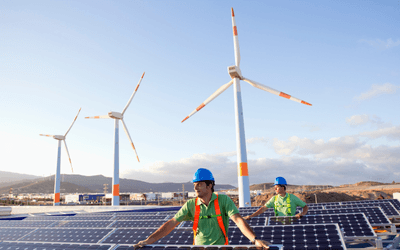For a STEM industry, engineering and construction (E&C) is surprisingly tech shy. McKinsey Global Institute’s Industry Digitization Index once named E&C as one of the least digitized industries globally. And more recently, research from IDC and Autodesk found that just 13% of construction businesses were striding ahead in their digital transformation journeys – despite 72% citing digitization as a key strategic priority.
Yet the potential for digital in the E&C sector is significant, not least because some of the most pressing issues worldwide rely on this intersection – such as the development of smart cities and faster construction to house a growing population, the threat of climate change and the role of sustainable development, and the rise of cyberwarfare over the last decade.
At an industry level, digitisation also promises to improve project efficiency, management, costs, and planning – according to McKinsey, digital transformation in the E&C sector could improve productivity by 14-15% and reduce costs by 4-6%. With rising demands for construction projects (workloads in the UK rose by 3.5% between October and November 2021), compounded by a tough market (Mace Consulting has recently predicted a 4.5% tender price hike in 2022 due to material and labour shortages), this is no small thing.
The industry can’t deny the inevitable for much longer. But to digitise the sector, first we must ramp up our data capability. Here’s my view on how data could reinvent the E&C industry.
Collaboration and co-ordination
One of the biggest sticking points in E&C is communication. E&C projects are traditionally made up of different contractors, subcontractors, and suppliers. Moreover, each project can vary significantly, making it difficult to ever establish consistent tools, methodologies, or ways of working. These independent moving parts make it all too easy for anomalies to slip through the cracks, impacting project timelines and budget. Part of this boils down to a lack of integration – 60% of E&C companies acknowledge they need to increase integration and visibility across risk functions.
Another challenge facing the industry is accessibility and visibility of data. Almost 96% of data captured is not put to proper use in the E&C industry. This lack of available information then bleeds into onsite experience – according to a 2018 report by FMI constructions teams spend 13% of their time looking for project data and information, meanwhile an ACG survey found that 75% of E&C firms experienced project delays due to longer lead times and market shortages – suggesting the industry struggled to make accurate predictions on the market. This becomes even more concerning in secure environments like defence - a recent policy paper on data strategy in the UK’s defence industry found that only a quarter of systems had data that was easy to access.
Naturally, there is an opportunity here for digital to join the dots and help the industry move from guesswork to insight-led decision making. Artificial intelligence and machine learning models are invaluable for unpicking historic data to anticipate future trends and needs, such as predicting market-wide resource or material shortages, identifying alternative solutions (and their likelihood of working), and identifying risks and process blockers. Digital supply networks (DSNs) can also use data (e.g. blockchain) to monitor materials through the supply chain and link up communications between different parties, meanwhile augmented reality (AR) can help E&C companies demonstrate the finished environment, ensuring that everyone is kept on the same page.
Prediction and patterns
When data is used to its full potential, we can understand trends and forecast to a scarily accurate degree. Part of this power comes through the Internet of Things (IoT) – a network of interconnected devices that capture and exchange information about the environment around them (a smart home is a great example of IoT in action).
Within construction, IoT can help us make predictions about future trends (such as energy consumption and growth of renewables by analysing consumer data), to improve communication within projects through real-time data across different sites (such as within logistics and fleet management), and for site maintenance. For example, we can anticipate machine failure before it happens by using IoT sensors to monitor real-time conditions and by using machine learning to interpret these readings against failure trends. The machine can therefore be removed, repaired, or replaced before it impacts the project. This information can then be relayed to everyone onsite using IoT-enabled smart devices, like mobile phones. In part one we saw one example of how using cutting-edge technology like drones and digital twins could take IoT to the extreme.
Another example of how IoT and data can enable predictive engineering is in urban planning. IoT can analyse a city’s traffic – such as population size and footfall in different regions, popular commuter times, and congestion areas – using technology like contactless travel and mobile data, in order to pinpoint areas for streamlining (such as requiring additional transport routes in high-traffic areas). This can then also feed into technology like autonomous vehicles (which themselves are data based), to improve the efficiency, quality, and environmental impact of the cities we live in.
Workforce reskilling and automation
Rising demand – job vacancies in the UK’s real estate and construction markets rose by 107% year-on-year in 2021, an all-time high – and a growing need for a more highly skilled, technical workforce, is causing a severe talent shortage in the E&C sector.
To meet this growing need, businesses will need to recruit and reboot digital skills internally – potentially even working with specialist suppliers (like Carbon60 and Lorien) to acquire the best talent. But digitisation can also help resource challenges too. Whether that’s using AI and machine learning to accurately resource plan and ensure the right skills are mapped to the right projects, or using technology such as automation or drones to remove some of the more repetitive, manual, or dangerous elements of work in E&C. For example, a robotic arm that can perform bricklaying or a digital twin that can precisely simulate the conditions in high-rise buildings, free up people that can be upskilled into more technical roles.
Final word
E&C has recovered phenomenally well from the chaos of the last two years. But E&C now requires a cultural shift to harness digital and accelerate into this demand. Cutting-edge technology doesn’t always land, especially where there is a lack of project consistency and an unfamiliarity with tech potential. Locating common pain points (both across projects and teams), identifying test cases, and focusing on upskilling the workforce to pivot from transactional activity to end-to-end, iterative, and agile working, will all ease digital adoption. In establishing this digital mindset, HR has a core role to play by helping E&C companies upskill their people, recentre their workforce and improve communication and collaboration between once disparate functions. If you would like to talk to me about how to hire the best people into your business to support your strategy, you can get in touch with me here.
Are you interested in learning more about data trends and how they could impact your business this year? Download our sister company Lorien’s free whitepaper Data Domination: the data trends transforming your business in 2022 and what HR and talent acquisition need to know about them to get an inside perspective on one of the most significant tech trends for this year.









